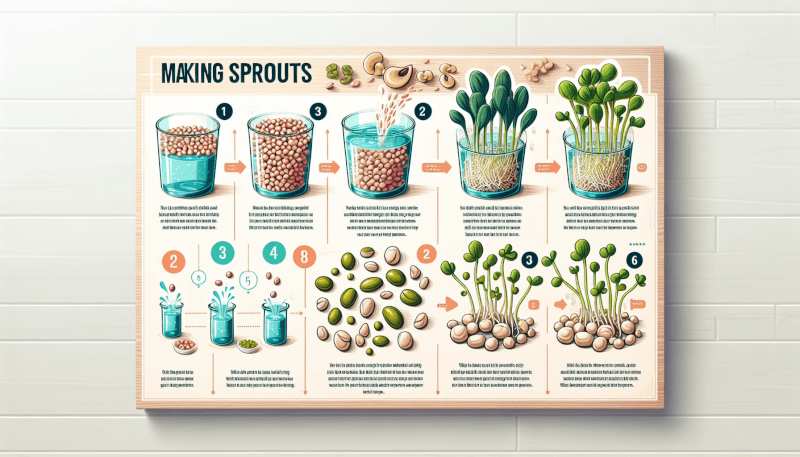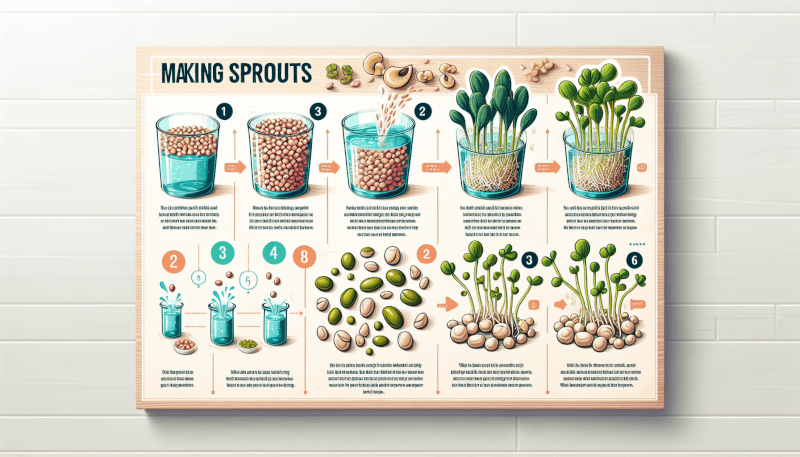Are you curious about how to make sprouts at home? Look no further! In this article, we will guide you through the simple steps to creating your own fresh and nutritious sprouts right in the comfort of your kitchen. You’ll discover the benefits of sprouting, learn about different types of sprouts, and master the art of sprouting seeds, grains, and legumes. Get ready to embark on a delicious and healthy journey as we uncover the secrets of making sprouts at home.

Choosing the right seeds
Consider the type of sprouts you want
When it comes to sprouting seeds at home, it’s essential to consider the type of sprouts you want to grow. Different seeds produce different types of sprouts, each offering its own unique flavor and nutritional benefits. Some popular options include broccoli, alfalfa, lentils, and mung beans. Think about the taste and texture you prefer, as well as the specific health benefits you are looking for when selecting your sprouting seeds.
Look for good quality seeds
To achieve successful sprouting, it is crucial to start with high-quality seeds. Look for seeds that are intact, plump, and free from any signs of damage or discoloration. Avoid seeds that appear shriveled, broken, or have a musty smell, as these may not germinate properly or could produce subpar sprouts. Purchasing from a reputable supplier or a local farmer’s market can help ensure the quality of your seeds.
Make sure the seeds are organic
Opting for organic seeds is a wise choice when sprouting at home. Organic seeds have been grown without the use of synthetic fertilizers, pesticides, or genetically modified organisms (GMOs). By choosing organic seeds, you minimize your exposure to potentially harmful chemicals and support sustainable agricultural practices. Look for the “certified organic” label on the seed packaging to ensure you are buying genuine organic seeds.
Preparing the seeds
Inspect the seeds for any impurities
Before soaking or sprouting the seeds, take a few moments to inspect them for any impurities. Remove any debris, stones, or damaged seeds that may have slipped through the initial screening process. This step may seem minor, but it helps ensure that only clean and viable seeds are used for sprouting, resulting in healthier and tastier sprouts.
Wash the seeds thoroughly
Properly washing the seeds is a critical step in preparing them for sprouting. Place the seeds in a colander or fine-mesh sieve and rinse them under cool, running water. Gently stir them with your hands to remove any dirt or residue. Repeat this process a few times until the water runs clear, indicating that the seeds are clean and ready for soaking.
Soak the seeds in water
After washing the seeds, it’s time to soak them. Fill a clean bowl or jar with enough water to fully submerge the seeds and allow them to expand. The soaking time can vary depending on the type of seeds, but as a general guideline, most seeds require an overnight soak of 8-12 hours. Soaking helps awaken the dormant seeds, kickstarting the sprouting process and making them easier to digest.
Choosing the sprouting method
Jar sprouting
One popular method for sprouting seeds is jar sprouting. It is a straightforward and convenient technique, suitable for beginners. To begin, you’ll need a glass jar with a wide mouth, a sprouting lid or mesh, and, of course, your soaked seeds.
Tray sprouting
Tray sprouting is ideal for growing larger quantities of sprouts. It involves using trays or containers with drainage holes to allow excess water to escape. Choose a tray with a suitable depth, ensuring that it provides enough space for the sprouts to grow.
Hemp bag sprouting
Hemp bag sprouting is excellent for those who prefer a more hands-off approach. This method involves using a clean hemp bag to hold the seeds during the sprouting process. The bag allows for air circulation while preventing the seeds from falling out.
Jar sprouting
Select a glass jar
When sprouting seeds in a jar, choose a glass jar with a wide mouth for easy rinsing and drainage. Avoid plastic containers, as they can harbor bacteria and may affect the flavor of the sprouts. The jar should be large enough to accommodate the expanding sprouts.
Rinse the seeds twice a day
To ensure the seeds remain clean and hydrated during the sprouting process, rinse them twice a day. Fill the jar with fresh water, swirl it around to rinse the seeds, and then drain off the water. This rinsing helps remove any impurities and provides a fresh supply of moisture for the growing sprouts.
Drain the water after rinsing
After each rinsing, it’s essential to drain off excess water thoroughly. Invert the jar at an angle, allowing the water to escape through the mesh or sprouting lid. Ensuring proper drainage prevents water from pooling at the bottom, which can lead to mold or rotting. Proper airflow and drainage help keep the sprouts healthy and prevent unpleasant odors.
Tray sprouting
Choose a suitable tray or container
When opting for tray sprouting, select a tray or container with drainage holes. These holes allow excess water to escape, preventing the sprouts from sitting in stagnant water. Choose a tray that provides ample space for the seeds to spread out and grow without overcrowding.
Spread the seeds evenly
To ensure even growth, spread the soaked seeds evenly across the tray or container. Avoid clumping them together, as this can hinder proper airflow and lead to moisture buildup. Gently pat the seeds down without compacting them excessively.
Spray water to keep them moist
To maintain the right moisture level for sprouting, it’s important to keep the seeds moist but not waterlogged. Use a spray bottle to mist the seeds with water once or twice a day, depending on the environmental conditions. Ensure the sprouts are evenly coated with the mist, providing them with the necessary hydration for healthy growth.
Hemp bag sprouting
Get a clean hemp bag
To start hemp bag sprouting, make sure you have a clean hemp bag specifically designated for sprouting. Hemp bags are durable, breathable, and allow for proper air circulation, promoting optimal sprout growth.
Spread the seeds inside the bag
Place the soaked seeds inside the hemp bag and ensure they are spread evenly and not clumped together. The bag should have enough empty space to allow the seeds to sprout and expand. Close the bag securely, ensuring there are no gaps or openings for the seeds to fall out.
Mist the seeds with water
To maintain moisture levels, mist the seeds in the hemp bag with water using a spray bottle. The misting should be done once or twice a day, depending on the environment’s humidity. Be sure not to oversaturate the seeds, as excess moisture can lead to rotting or mold growth.
Providing the right conditions for sprouting
Keep the sprouts in a warm place
To encourage optimal sprouting, it’s crucial to provide the seeds with a warm environment. Place the sprouting container or bag in a location where the temperature remains consistently between 65-75°F (18-24°C). Avoid exposure to extreme temperatures, which can hinder sprout growth or even kill the seeds.
Avoid direct sunlight
While sprouts need some light to activate the photosynthesis process, direct sunlight can be too intense and may cause the sprouts to dry out or become overheated. Place the sprouting container or bag in a spot that receives indirect sunlight or opt for artificial light sources like fluorescent or LED lamps.
Ensure proper ventilation
Sprouts require proper airflow to prevent excess moisture and to discourage the growth of harmful bacteria. Ensure there is adequate ventilation around the sprouting container or bag. Avoid sealing them in airtight compartments, which can create a breeding ground for bacteria and lead to the development of foul odors.
Rinsing and draining
Rinse the sprouts twice a day
To maintain the cleanliness and freshness of the sprouts, rinse them twice a day. Fill a clean bowl with water and gently transfer the sprouts into the bowl, swishing them around to remove any debris. Lift the sprouts out of the water and let any excess moisture drain away.
Allow the sprouts to drain completely
After rinsing, it’s crucial to ensure that the sprouts drain completely. Excess water left in the sprouting container or bag can encourage bacterial growth, leading to spoilage. Place the sprouts in a colander or sieve and let the water drain away completely before returning them to their designated sprouting space.
Avoid excess moisture
While it’s essential to maintain adequate moisture levels during sprouting, excess moisture can be detrimental. Avoid keeping the sprouts in standing water or excessively damp conditions as this can cause rotting or mold growth. Strive for a balance between moisture and proper airflow to promote healthy growth and prevent spoilage.
Observing growth and maturity
Check for signs of sprouting
As the sprouting process progresses, it’s exciting to see the seeds begin to sprout and transform. Observe the sprouts closely for signs of growth, such as small roots or shoots emerging from the seeds. Depending on the type of seeds, you may notice different rates of sprouting, but typically within a few days, visible growth can be observed.
Monitor the growth process
Continue to monitor the growth of your sprouts throughout the process. Ensure that the sprouts remain adequately moist and do not dry out. Check for any signs of discoloration, unpleasant odors, or sliminess, as these may indicate spoilage or bacterial growth. Healthy sprouts should have a fresh appearance, crisp texture, and a mild, pleasant aroma.
Harvest the sprouts at the desired stage
When the sprouts have reached the desired stage of growth, it’s time to harvest them. This stage can vary depending on personal preference and the type of sprouts. Some may prefer shorter sprouts, while others may prefer longer ones. Gently remove the sprouts from their sprouting container or bag, rinse them once more under cool water, and pat them dry before enjoying their fresh and crunchy goodness.
Safety precautions and tips
Cleanliness is crucial
Maintaining a clean sprouting environment is essential for preventing the growth of harmful bacteria. Thoroughly wash all sprouting equipment, including jars, trays, mesh lids, and hemp bags, before and after each use. Avoid cross-contamination by using separate utensils and cutting boards when handling sprouts and other food items.
Avoid consuming spoiled sprouts
If you notice any signs of spoilage, such as a foul odor, sliminess, or mold growth, discard the entire batch of sprouts. Consuming spoiled sprouts can lead to foodborne illnesses, so it’s crucial to prioritize food safety. When in doubt, it’s always better to err on the side of caution and choose fresh, healthy sprouts.
Be cautious with sprouting grains
While sprouting grains can offer numerous health benefits, they require a more meticulous approach due to the risk of bacterial contamination. Grains tend to be more susceptible to spoilage and can harbor harmful bacteria such as E. coli or Salmonella. Properly researching and following appropriate guidelines for sprouting grains is vital to minimize any potential health risks.
By following these tips and techniques, you can easily and successfully sprout seeds at home. Enjoy the fresh and nutritious goodness that sprouts bring to your meals, and experiment with different varieties to discover your favorite flavors. Happy sprouting!



